Sophie Morgan is an acclaimed natural history TV producer and field director, with recent credits including BAFTA and EMMY award-winning series Blue Planet II and National Geographic’s landmark EMMY nominated series Hostile Planet.
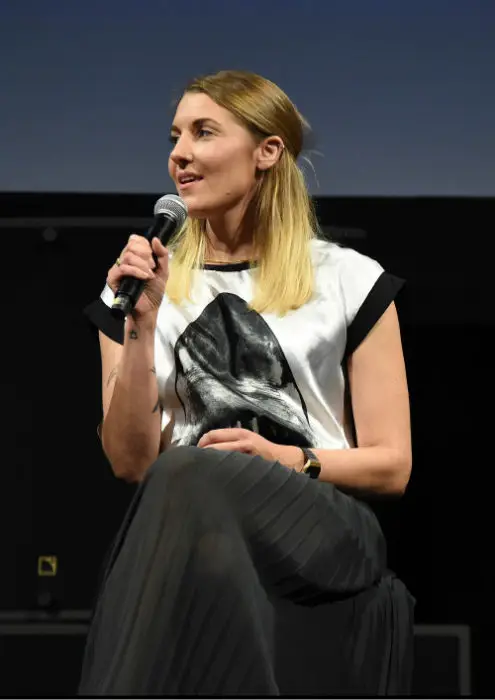
Originally from London, she discovered her affinity for the big blue and marine life at the bottom of rook pools during family holidays. In her early twenties, she took the plunge and completed her PADI Open Water in Sodwana Bay on the African plains. Fast forward to now and from the Arctic fjords to remote coral atolls, Sophie films new marine behaviors and manages complex dive shoots in demanding oceanic environments around the globe. She is passionate about using cutting edge filming tools and new perspectives to reveal a world that is inaccessible to many, as it was when she was a young Londoner.
In equal measure to her success in media diving, Sophie is a pro-active conservationist who uses original storytelling techniques to inspire people to care about the ocean and its inhabitants.
For her next credit Sophie is working on an underwater episode of another major series for Plimsoll Productions, and no doubt in the background she is thinking up more initiatives to help save our oceans.
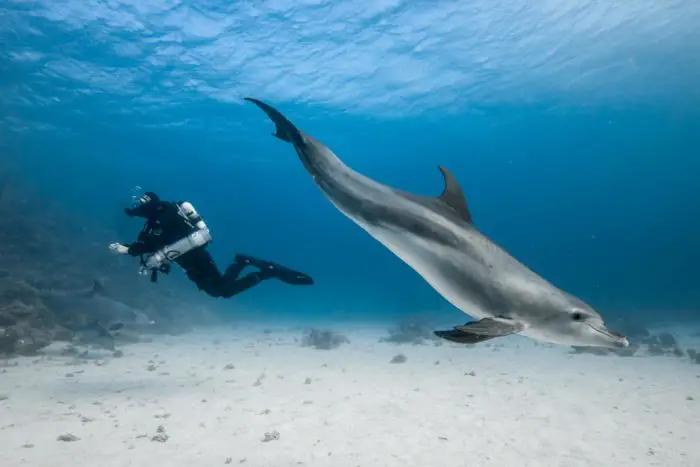
DeeperBlue.com: When was your first dive?
SM: I’ve always been comfortable in the water, but as a London kid I didn’t have much access to it. I’d spend every family summer holiday rock pooling or snorkeling, but I was a relative latecomer to diving. The African plains were my first wild love and it was on the back of a scientific wildlife-surveying trip in South Africa in my early 20s that I did my PADI Open Water in Sodwana Bay. The dives themselves were fairly uneventful, but breathing underwater whilst collecting fresh shark teeth and listening to the song of humpback whales, was just so damn cool.
DB: Current certification level?
SM: rEvo CCR Mod 1; HSE Pt IV; PADI Divemaster
I’ve been diving a rEvo rebreather for just over a year now and have spent approx. 250 hours on it underwater – much of it on wildlife filming projects (after building a healthy number of hours of course). It’s the system of choice for the majority of underwater camera operators, due to simplicity, redundancy, and the capability to fix most issues in the field with a good spares set.
I don’t use it in the same way as most CCR divers to do deep technical dives. Like most people in our industry, I use it to extend my bottom time at fairly shallow depths and reduce my bubbles. In the wildlife film-making industry, rebreathers have leveled the playing field with land-based filming, in terms of silent long term observation of a subject. We can spend 6-7 hours underwater a day, with complex grip equipment (sliders, tripods, motion control rigs) and reveal never before seen marine behavior – and the fish can’t hear us coming from 100m away, like with OC! I noticed the difference in wildlife behavior around me during my training in the Red Sea – the dolphins and turtles there were far more welcoming when I stopped sounding like Darth Vader.
DB: Describe your route into wildlife and TV?
SM: I eventually did a Zoology BSc at Bristol University, after canceling my original plans to become a vet – I’ve always adored animals and my careers officer didn’t have much of an imagination. Thankfully I realized in time that what I wanted was to be in the field, observing animal behavior.
Despite studying in Bristol – the epicenter of global wildlife television – I had zero ideas that my degree and my student media involvement were appropriate training for this industry. I was head-hunted straight out of student radio/journalism to work in music PR in London, which didn’t fulfill me and I wanted to use my skills to promote science and conservation, so I started job hunting. An advertisement for a Researcher at the BBC Natural History Unit led me straight back to an interview in Bristol. One I didn’t get, but that encouraged me enough to quit my job for two weeks of work experience at another independent production company in the city. I was lucky enough to get an original idea commissioned by BBC Natural World in my initial months there, which helped to kick-start my career, and got me my first Researcher credit. In the 10 years following I’ve worked my way up to Producer.
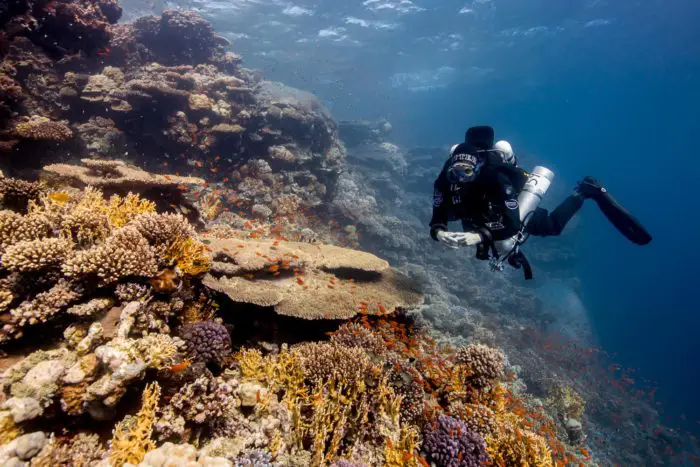
DB: What came first – diving or media?
SM: On a professional level, media definitely came first, and being a documentary researcher pushed forward my interest in the water. In this role you are always looking for novel stories and I was finding that underwater was where to look. I’ve always been slightly envious of the original explorers, who got to experience so many new species and behaviors, and the more I researched the more the ocean felt like this exciting final frontier. I also felt that we were/are at a crossroads where the technology was allowing us to dive further and deeper, but marine life is diminishing at an alarming rate. This was what I wanted to make films about and this is what I wanted to protect. However, I needed to improve my dive skills seriously to do it.
I fell back in love with diving in a serious way and became very focused on progression and safety. In around a year I went from a fair-weather PADI wetsuit diver to an HSE IV commercial diver doing regular cold-water UK drysuit dives. I’ve been very committed to keeping current and updating my training ever since, which is incredibly important in my role.
DB: What was your role on Blue Planet 2?
SM: Working on Blue Planet 2 was my life goal, but I had been more presenter-wildlife focused and didn’t have blue-chip nature programming experience. My commitment to diving and underwater was thankfully enough for the Executive Producer, James Honeyborne, to give me a shot. I actually stepped down a level back to Researcher to do it – a move, which was 100% right and undoubtedly, made me the Producer I am today. It gave me the incredible opportunity to work under renowned Producer Miles Barton, whose teachings have been the most relevant and useful of my career. A researcher is largely responsible for story and information finding, but there were also opportunities to assist in the field, and I used my dive qualifications to also act as Dive Supervisor and OC Safety Diver at times. As the project moved forward Miles also gave me the opportunity to solo direct my first blue-chip behavior sequences.
DB: Have you met the big D (Sir David Attenborough)?
SM: No. I have a lot to thank him for too. As a child, I was sat in front of countless nature programs that he narrated, so it is no surprise that my career followed in his footsteps. Unfortunately, my travel schedule for Hostile Planet meant I missed the opportunity to be involved in the press for BP2 and meeting Sir David. However, I did hear that, at an event, he specifically mentioned liking one of my sequences, and that’s enough for me.
DB: What was your role on Hostile Planet?
SM: I directed the ‘Oceans’ episode of ‘Hostile Planet’, as well as setting up the stories and running the international dive operations. Plimsoll Productions must have been and must still be one of the most exciting and fastest-growing independent production companies around. And what’s more, they have Dr. Martha Holmes as Head of Wildlife – a legend of diving and underwater filmmaking (BBC Life – Fish, BBC Blue Planet), who I was hugely keen to work with. When I heard they had an ‘Ocean’ episode planned for their first blue-chip commission, I was intrigued. When I heard ‘Hostile Planet’ would feature not only extreme environments but tackle the fact that these extremes are increasing due to human-induced change, I was sold. And by this time, I had the right skills for the job…apart from being CCR trained at the time, which often left me Dive Supervising on the surface.
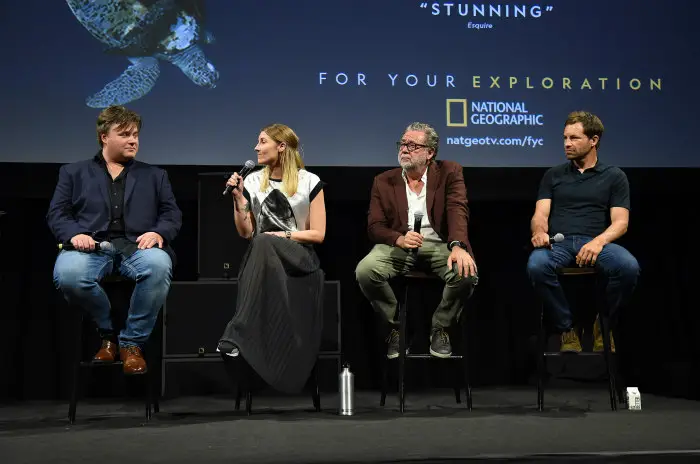
DB: What is it like working at the front line?
SM: It can be tough. When it’s your job to find and film wildlife you become very aware of recent environmental changes – epic fish runs of ten years ago that are now a trickle, turbulent weather in a historically stable season, etc. Animals and events are becoming harder to find and predict across the globe and pristine habitats are a thing of the past. And even then it’s a story of shifting baselines – I was excited to see around ten sharks on a dive in Chagos (BIOT), only to be told that a few decades ago I would have encountered more than a hundred.
But it’s also a huge privilege. The world is not yet destroyed and there are many incredible places and animals that are still worth showing to an audience. And there is the occasional good news story that gives you hope. In ‘Hostile Planet – Oceans’ we featured blue whales in California and olive ridley turtles in Costa Rica that both have bounced back from the brink since stricter hunting and fishing regulations were introduced. Proof that some elements of nature can recover if they are just given the opportunity.
DB: Are you a bit too young to be this rad already?
SM: If you mean ‘cool’ I’m not sure I’m that, but I’ve always been a bit radical. I’m very driven and have never been afraid to give a voice to my passions and beliefs. Age 4 I thought nothing of walking up to women in fur coats and repeating the campaign slogan of the time, ‘It takes up to 40 dumb animals to make a fur coat and only one to wear it’. My approach has got a little less aggressive, but I still have the conviction to make important points like this via my films.
DB: How do you decide your episode themes and content?
SM: By the time I step onto a production it usually has a strong series-wide theme. It’s my job as a Producer to create a program that has a unique voice but also feels like a part of the wider project. I then work with an editorial team to find stories that fit that theme and provide a strong narrative arc and sense of story.
‘Hostile Ocean’ journeyed the whole ocean, so we had the pick of stories of animals surviving in a variety of different marine habitats, which allowed for some strong behavior and a wonderful diversity of imagery. I knew from the start that I wanted to tackle the biggest problems in the ocean from an animal point of view, without losing the cinema and the drama. So I focused heavily on integrating visually beautiful overfishing and increasing carbon sequences into the overall narrative. National Geographic Channel was refreshing supportive of this.
DB: What is the role of a Director?
SM: I’m both a Producer and a Director. I’ve mostly explained the producer role above, although it also includes a lot of logistics, managing, and budgeting that I won’t bore you with. I also direct and work with other directors to bring stories to life – this means working with camera operators in the field to build a sequence of images that effectively tell the story and being able to react as that story shifts on location.
If you are, like me, directing on dive shoots, the chances are that you are also part of the dive team because there is limited room on boats! I generally like to separate the two roles and focus on safety when I am underwater. However, I find being down there and seeing the scenery and behavior (or lack of) first hand allows me to make better-informed decisions about how to deliver the sequence. Occasionally I make director notes on my slate, but things can get weird after 6 hours underwater and they sometimes come out like haikus – cue my team laughing into their loops.
DB: Tell me about your panel discussion in the States?
SM: As the Director of the program, National Geographic Channel invited me to join some panel discussions at ‘Hostile Oceans’ screenings in LA, which was a real honor. The audiences were really receptive to both the film’s powerful cinematography and the environmental messages, which I found an uplifting sign of the times. Being given a platform to discuss both the artistry of filmmaking and conservation was a dream, and proof that the two don’t have to be mutually exclusive.
DB: Any more press events coming up?
SM: Likely not until my next show is out. I have promised to do the UK dive lectures for you soon though!
DB: Can you elaborate on the busy work and travel schedule you and your team have?
SM: Well last year I spent less than 6 months at home in Bristol. The teams on dive projects are often more like a family, as we really do rely on each other to survive. We all really care about what we are doing and thus work spectacularly hard to achieve on location. It’s not a job for the faint-hearted, but the rewards can be massive, and we get to dive in and capture footage of the most incredible and remote places on the planet.
The irony of my carbon footprint is not lost on me, and I am working to amend this by staying out on location for longer and employing remote crew where possible. I do think it’s an issue the industry needs to address as a whole, but I also believe that the environmental passion our work sparks offsets it somewhat.
DB: Who are your mentors?
SM: As above, working under Miles Barton at the BBC made me the Producer I am today.
Another mentor of mine would be Neil Brock of Bristol Channel Diving – an unsung hero of the TV dive industry, who has been involved in overseeing the safety of most major underwater productions in recent years. Neil keeps me on the straight and narrow with regards to current international safety regulations and any additional dive training I need for shoots. He also fixes a lot of my gear, quite often on a tight deadline, and has nicknamed me ‘Calamity Jane’ as a consequence.
I recently had the opportunity to work and assist diving with Doug Anderson, widely regarded as one of the top underwater camera operators in the world – someone I have admired since I joined the industry. Being a rather novice rebreather diver I was nervous, but couldn’t have begun my CCR career with a more supportive work ‘buddy’. Having dived the rEvo all over the world, his advice and troubleshooting ability were invaluable to my progression. And from a creative point of view, he’s just so exciting to work with.
DB: Do you have any Role Models?
SM: I’ve always admired strong women in the underwater world – especially those who entered it when it was very much seen as a man’s work, such as blue conservation superstar Dr. Sylvia Earle, shark lady Dr. Eugenie Clark and the lesser-known Jean Villepreux-Power who invented the first aquariums to study paper nautiluses in the 1800s. Martha Holmes, whom I work for at Plimsoll, is also a total badass and was presenting Sea Trek in a bubble helmet before I even looked at a pair of fins. Things have changed and there are far more female marine scientists and divers making a name for themselves, but I am still reminded of it when I struggle to find technical dive clothing that fits me. Again something that is changing – Fourth Element just informed me their new tech shorts come in XS!
DB: What is in your kit bag?
SM: Sticking purely to diving, Fourth Element, Apeks, and Otter Drysuits are all great British brands that have provided me with support and last-minute fixes/solutions over the years. And I’ll give a shout out to Shearwater, who kindly sorted us out with a replacement NERD on a recent shoot.
DB: Tell us about a career highlight.
SM: Finding a really spectacular new behavior is not something that happens every day. Filming giant trevallies hunting birds for Blue Planet 2 was a once in a lifetime moment – especially when we headed out there on nothing more than a fisherman’s tale, a huge risk to the production (calculated risk and several reports, but not a single existing photograph). Underwater Cameraman Dan Beecham and I also got to dive a spot that almost no-one else had with critters that had never seen a diver – me with jet lag, forgetting the symbol for manta and just pointing, gave him a fright as he came face to eyeball with one on our check dive.
However, the real career highlight is when your shows have a lasting impact, be it on one person or many. Seeing Blue Planet 2 induce a real change in human plastic consumption (also a lot due to the many charities and NGOs already campaigning in this area) was incredibly exciting and has opened the door for more conservation campaigning in wildlife programming. I just hope we can now do the same for climate change and overfishing, which are far bigger threats for the ocean.
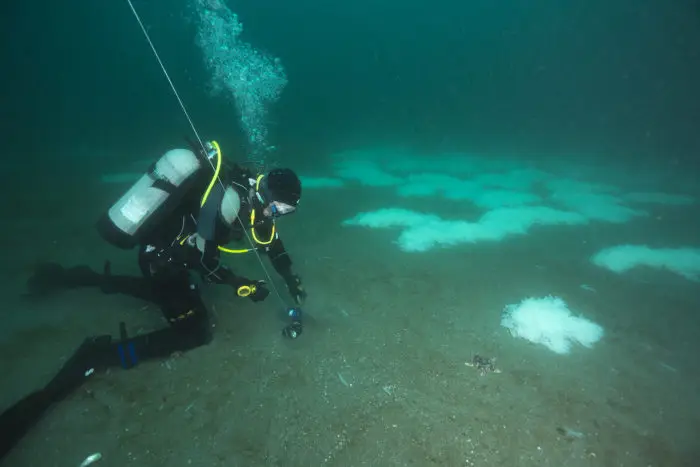
DB: Favourite wildlife interactions
SM: My recent rebreather work has led me into the world of benthic filming. Being able to sit on the bottom in the top productive layer of the water for 6-7 hours a day has allowed me to get to know habitats and observe fish and invertebrate behavior like never before. It also gives you a real opportunity to habituate marine animals to your presence – I’ve witnessed and filmed some really intimate and special moments for my current program.
DB: Any hairy moments in the field?
SM: In a professional capacity and as a team leader I’m always wary to dive well within my limits. The opportunity to do a lot of warm water benthic filming on my current project was what opened the door for me to step up to CCR diving on a safe commercial level. However, I’m still at a stage where I would leave more difficult shoots to more experienced divers and instead operate as supervisors working to keep them safe. When filming orca and humpbacks in Norway, in addition to the large subjects, the divers were in wetsuits in cold water for maneuverability, there were strong currents, fishing boats and very little light available – even the best safety diver in the business (John Chambers) got caught yelling expletives into the comms as a large oblivious humpback whale crashed past him.
Having said that, even a simple-seeming dive can test you. OC scouting for squid eggs at 35-40m in California for ‘Hostile Planet’ and finning too fast in a drysuit after my buddy, gave me a nasty combination of narcosis and hypercapnia. It left me confused and with a novel feeling of dread that made me want to bolt to the surface – thankfully quickly fixed by swimming slowly slightly up to the anchor line and breathing for a few minutes, whilst I figured out what was going on. I’m a big believer that panic is the greatest enemy of the diver, and I’m glad that my training allowed me to override it.
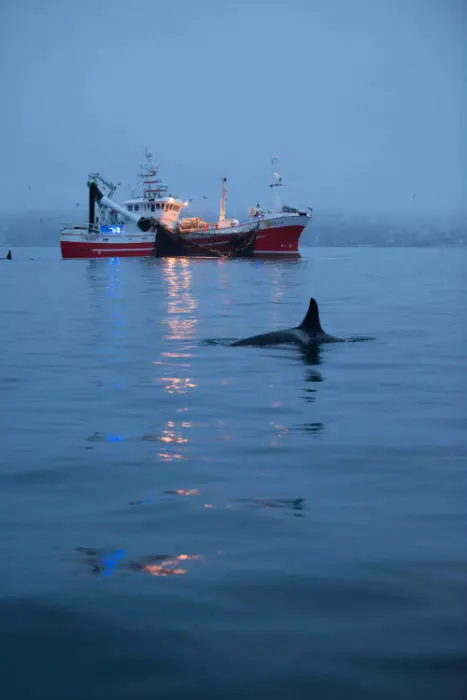
DB: What will you learn next?
SM: Every day is a learning day, as technology marches forward underwater I am under an obligation to keep up with it to produce the best TV and keep my team safe. My next planned purchase is an M48 Mod-1 Kirby Morgan full-face mask with communications set up. Full-face masks are invaluable tools on more complex shoots – for communication between divers for setup, and for communication with the surface for safety. They can be a little claustrophobic if you are out of practice, so I’ve been advised to wear it in the shower! However, I know, as an experienced Dive Supervisor, that it is important not to rely on comms in a shifting wild environment and have back up safety protocols in place, should they fail. Ultimately it’s all about getting the best job done, but safely.
DB: What is the big dream?
SM: I’m in the midst of hatching an exciting plan to continue my career whilst living by the sea, as it is where I feel most at peace. I’d also like to work more with local teams in that region to reduce the carbon footprint of documentary filming.
Ultimately, I want to keep working on underwater filming projects that excite me and challenge me from a creative point of view and hopefully also have a positive impact from an environmental angle. As the world changes, I believe we have a moral obligation to show it and I don’t think conservation has to have a negative impact on cinema – feature film can be depressing if it is beautiful and I think ‘Hostile Planet’ hits that mark with its glittering fish scales and alien jellyfish expansion. I’m under no illusion that I’m going to save the world, but I’m on a mission, to tell the truth.
Follow Sophie’s adventures on Instagram: @sophiedives

